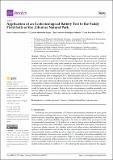Por favor, use este identificador para citar o enlazar a este item:
http://hdl.handle.net/10261/278530COMPARTIR / EXPORTAR:
 SHARE SHARE
 CORE
BASE CORE
BASE
|
|
| Visualizar otros formatos: MARC | Dublin Core | RDF | ORE | MODS | METS | DIDL | DATACITE | |

| Título: | Application of an Ecotoxicological Battery Test to the Paddy Field Soils of the Albufera Natural Park |
Autor: | Andreu-Sánchez, Óscar; Moratalla-López, Jesús; Rodríguez Martín, José Antonio ; Roca-Pérez, Luis | Palabras clave: | Albufera Natural Park Bioassays Ecotoxicity Heavy metals Risk assessment |
Fecha de publicación: | 5-jul-2022 | Editor: | Multidisciplinary Digital Publishing Institute | Citación: | Toxics 10(1): 14 (2022) | Resumen: | Albufera Natural Park (ANP) (Valencia, Spain) is one of the most important wetland areas of the Mediterranean coast subject to high anthropogenic pressure, on whose soils a battery of bioassays has never been applied to evaluate the ecotoxicological risk. The present study determined available and water-soluble heavy metal content in four paddy soils used in the ANP, and the ecotoxicological effect on these soils was evaluated by performing the bioassays regulated in Spanish Royal Decree 9/2005. Soil properties and extractable Co, Cr, Cu, Ni, Pb and Zn (EDTA pH = 7) were analyzed in soils. These elements and macro- and micronutrients were also assessed in soil leachate. A test battery covering the following was needed: acute toxicity test in Eisenia foetida (OECD TG 207); mineralization tests of nitrogen (OECD TG 2016) and carbon (OECD TG 217); growth inhibition test in Raphidocelis subcapitata (OECD TG 201); mobility inhibition test in Daphnia magna (OECD TG 202). The soils found in the most anthropized areas to the north of the ANP (Massanassa and Alfafar) demonstrated a higher concentration of available heavy metals than in the southern ones (Sueca and Sollana). The aqueous leachate of the studied soils contained very low concentrations, which would be related to soil properties. Despite the high concentration of available potentially toxic elements (PTEs) in the Massanassa and Alfafar soils, the studied soils showed no toxicity during the performed battery bioassays. Therefore, soils can be considered non-toxic despite the obtained PTEs available concentration. | Descripción: | 16 Pág. Departamento de Medio Ambiente y Agronomía (INIA) | Versión del editor: | https://doi.org/10.3390/toxics10070375 | URI: | http://hdl.handle.net/10261/278530 | DOI: | 10.3390/toxics10070375 | ISSN: | 2305-6304 |
| Aparece en las colecciones: | (INIA) Artículos |
Ficheros en este ítem:
| Fichero | Descripción | Tamaño | Formato | |
|---|---|---|---|---|
| Application-of-an-Ecotoxicological-Battery-Test-to-the-Paddy.pdf | artículo | 2,15 MB | Adobe PDF |  Visualizar/Abrir |
CORE Recommender
Page view(s)
44
checked on 16-may-2024
Download(s)
40
checked on 16-may-2024
Google ScholarTM
Check
Altmetric
Altmetric
Este item está licenciado bajo una Licencia Creative Commons

